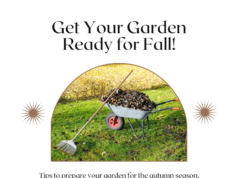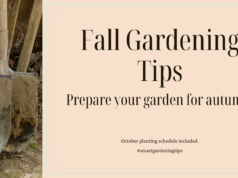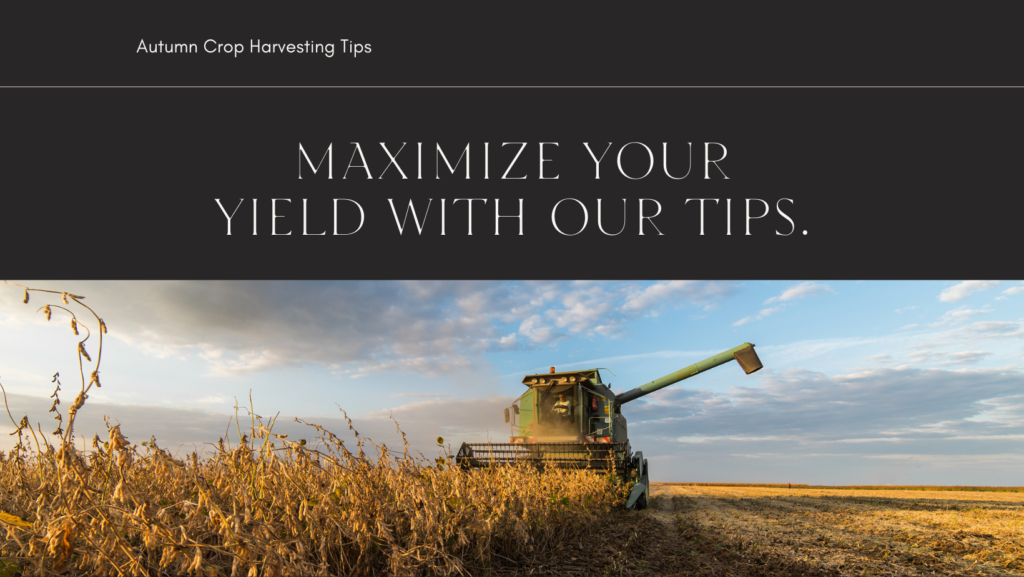
Welcome to our expert guide on autumn crop harvesting! If you’re looking to maximize your autumn crop yield and learn storage and preservation techniques tailored for the season, you’ve come to the right place. Autumn is a crucial time for harvesting, and by following our tips, you can ensure a bountiful harvest and preserve the quality of your crops for longer.
Key Takeaways:
- Timing and preparation are vital for efficient autumn crop harvesting.
- Having the right tools and equipment ensures a smooth harvest.
- Choose the right crops for autumn harvesting to optimize yield and quality.
- Follow proper harvesting techniques to minimize damage and spoilage.
- Learn the best practices for storing and preserving your harvested crops.
Timing and Preparation for Efficient Harvesting
Timing and preparation are crucial factors for efficient autumn crop harvesting. By understanding the optimal timing for harvesting different crops and properly preparing for the harvest, you can maximize your yield and ensure a successful harvest.
When it comes to timing, it’s important to consider the maturity of the crops. Different crops have different ideal harvesting times based on factors such as color, texture, and taste. Here is a general guideline for the timing of some common autumn crops:
| Crop | Ideal Harvest Time |
|---|---|
| Apples | When the fruit is fully colored and easily separates from the tree with a gentle twist. |
| Pumpkins | When the skin becomes hard and the stem begins to dry out and turn brown. |
| Squash | When the skin is firm and cannot be easily punctured with a fingernail. |
| Carrots | When they reach the desired size and color and the soil is loose for easy harvesting. |
Preparation is equally important for efficient harvesting. Here are some tips to ensure you are well-prepared for a successful harvest:
- Plan Ahead: Create a harvest schedule based on the ideal timing for each crop to avoid missed harvest opportunities.
- Gather the Right Tools: Ensure you have the necessary tools such as pruners, shears, or shovels to safely and efficiently harvest your crops.
- Prepare Storage Space: Clear and organize storage areas in advance to accommodate the harvested crops and minimize the risk of damage or spoilage.
- Inspect and Maintain Equipment: Check and maintain your harvesting equipment to ensure they are in proper working condition to avoid interruptions or delays during harvesting.
By timing your harvests correctly and adequately preparing for efficient harvesting, you can optimize your autumn crop yield and set yourself up for a successful harvest season.
Essential Tools for Autumn Crop Harvesting
When it comes to autumn crop harvesting, having the right tools and equipment is essential for a smooth and efficient process. With the proper tools at your disposal, you can maximize your yield and ensure a successful harvest. In this section, we will highlight the essential tools needed for autumn crop harvesting and provide tips on equipment maintenance and safety.
1. Harvesting Knife: A sharp and sturdy harvesting knife is a must-have tool for cutting through tough stems and branches. Look for a knife with a comfortable grip and a strong, sharp blade that can easily slice through vegetation without causing damage to the plants.
2. Pruning Shears: Pruning shears are essential for trimming leaves and branches, allowing for better access to fruits and vegetables during the harvesting process. Look for shears with a bypass cutting mechanism for a clean and precise cut.
3. Garden Fork: A garden fork is useful for lifting and turning soil, loosening roots, and gently removing plants from the ground. Choose a fork with sturdy tines that can withstand heavy-duty use.
4. Wheelbarrow: A sturdy wheelbarrow is indispensable for transporting harvested crops from the field to your storage area. Opt for a wheelbarrow with a large capacity and durable construction to handle the weight of your harvest.
5. Storage Containers: Properly storing your harvested crops is crucial for maintaining their freshness and quality. Invest in high-quality storage containers, such as plastic bins or wooden crates, that offer adequate ventilation and protection from pests.
6. Safety Equipment: Ensuring your safety during the harvesting process is paramount. Equip yourself with the necessary safety gear, including gloves, goggles, and sturdy footwear, to protect yourself from potential hazards.
Remember to regularly inspect and maintain your tools and equipment to ensure their longevity and optimal performance. Clean and oil metal tools to prevent rust and sharpen blades when necessary. Additionally, always follow safety guidelines to minimize the risk of accidents and injuries.
With these essential tools and proper equipment maintenance, you’ll be well-prepared to tackle your autumn crop harvesting with ease and efficiency.
Crop Selection for Autumn Harvesting
Choosing the right crops for autumn harvesting is crucial to optimizing yield and quality. To ensure a successful harvest, it is important to select crops that are well-suited for the autumn season. Here are some key factors to consider when choosing crops for your autumn harvest:
- Climate and Frost Tolerance: Consider the climate in your region and choose crops that can withstand cooler temperatures and potential frost. Some crops, such as kale and Brussels sprouts, actually improve in flavor after exposure to frost.
- Shorter Maturity Times: Opt for crops that have shorter maturity times, as the days start to shorten during autumn. This will allow you to harvest your crops before the colder weather sets in.
- Storage and Shelf Life: Select crops that have good storage capabilities and can maintain their quality over time. This will ensure that you can enjoy your harvested produce well into the winter months.
- Seasonal Favorites: Choose crops that are traditionally associated with autumn, such as pumpkins, winter squash, and hearty root vegetables. These crops not only thrive during this season but also add a festive touch to your harvest.
By carefully considering these factors and selecting the right crops for your autumn harvest, you can optimize both the yield and quality of your produce.
Best Harvesting Techniques for Different Crops
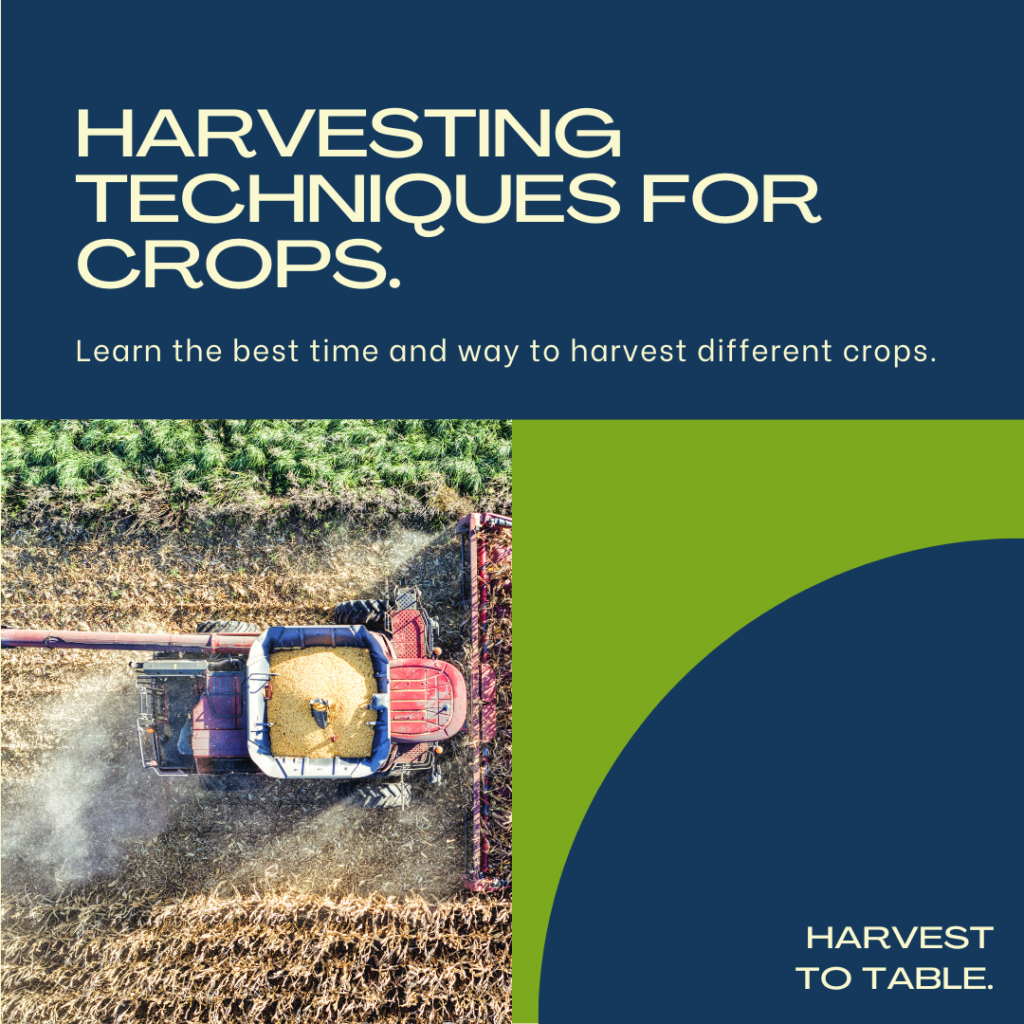
Different crops require specific harvesting techniques to ensure minimal damage and spoilage. By implementing best practices, you can maximize the yield and quality of your autumn crops. In this section, we will provide you with expert advice on how to harvest various crops, tailored to their unique characteristics.
Harvesting Techniques for Leafy Greens
Leafy greens, such as lettuce and spinach, are delicate crops that require careful handling during harvesting to prevent bruising and wilting. Follow these techniques to minimize damage:
- Harvest early in the morning or late in the evening when temperatures are cooler.
- Use sharp, clean shears or knives to cut the leaves, avoiding tearing or crushing.
- Handle the harvested greens gently, avoiding unnecessary bending or folding.
- Store the leafy greens in perforated bags or containers to maintain freshness.
Harvesting Techniques for Root Vegetables
Rustic root vegetables, such as carrots and potatoes, require careful extraction from the soil to minimize damage. Follow these techniques for successful harvesting:
- Loosen the soil around the base of the plant using a garden fork or spade.
- Gently pull the vegetables out of the soil, taking care not to break or damage the roots.
- Remove excess dirt by gently shaking or brushing off the vegetables.
- Allow the root vegetables to air dry before storing in a cool, dark place.
Harvesting Techniques for Fruiting Crops
Fruiting crops, such as tomatoes and peppers, require a different approach to ensure optimal harvest and quality. Follow these techniques for successful harvesting:
- Inspect the fruits regularly and harvest when they are fully ripe.
- Use sharp pruning shears or scissors to cut the fruits from the plant, avoiding any damage to the stems or surrounding fruit.
- Handle the harvested fruits with care to prevent bruising or splitting.
- Store the fruits at room temperature to allow them to fully ripen before consumption.
Harvesting Techniques for Crops with Edible Stems
Crops with edible stems, such as asparagus and rhubarb, require special techniques to ensure the optimal harvest of tender and flavorful produce. Follow these techniques for successful harvesting:
- Cut the stems close to the base using a sharp knife or shears.
- Harvest the stems when they reach the desired length and thickness.
- Handle the harvested stems carefully to avoid any damage.
- Store the harvested stems in a cool, moist environment to maintain their freshness.
Harvesting Techniques for Grains
Grain crops, such as wheat and rice, require specific techniques to ensure a successful harvest and minimize grain loss. Follow these techniques for optimal results:
- Harvest the grains when they are fully mature and dry.
- Use a combine harvester or hand tools, depending on the scale of your harvest.
- Thresh the harvested grains to separate them from the chaff.
- Properly clean and store the grains in a dry and ventilated area.
Remember, each crop has its own unique harvesting requirements. By implementing these best practices, you can minimize damage and spoilage, ensuring the highest possible yield and quality for your autumn crops.
Proper Storage Methods for Harvested Crops
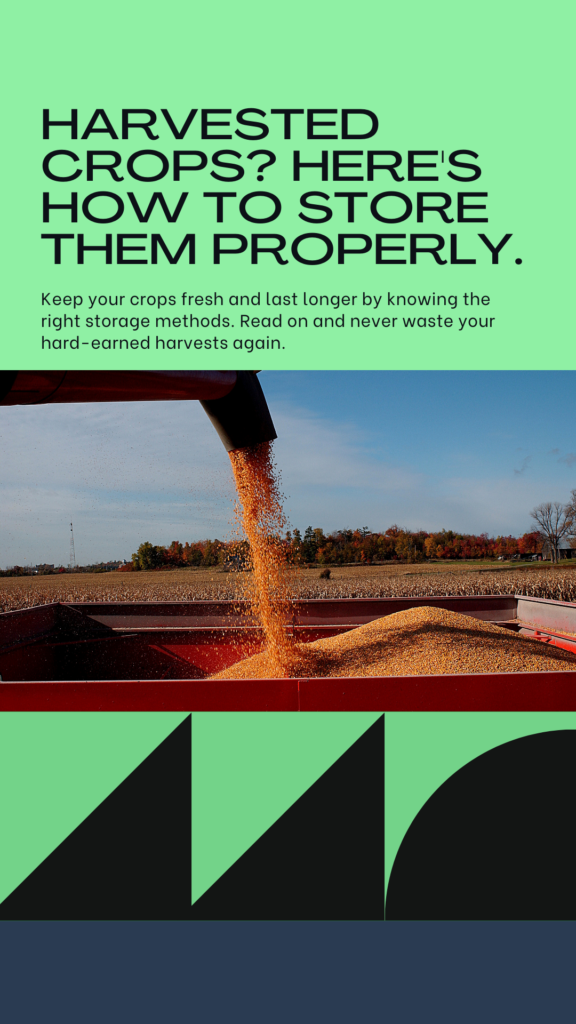
After a successful autumn harvest, proper storage methods are essential to maintain the freshness and quality of your crops. Implementing the right storage techniques and preservation methods will extend the shelf life of your harvested produce, ensuring that you can enjoy the fruits of your labor for an extended period.
Here are some best practices for storing your autumn crops and preserving their nutritional value:
1. Temperature and Humidity Control
Maintaining the ideal temperature and humidity levels is crucial for preserving the quality of your harvested crops. Different fruits and vegetables require specific conditions, so it’s important to research and identify the optimal storage parameters for each type of produce. Commonly recommended temperature ranges for storage include:
| Produce | Temperature Range (°C) |
|---|---|
| Apples | 0-4 |
| Potatoes | 7-10 |
| Carrots | 0-4 |
| Tomatoes | 10-13 |
Additionally, maintaining the appropriate humidity levels helps prevent dehydration or excess moisture, which can lead to spoilage. Investing in a digital hygrometer can assist in monitoring and adjusting humidity levels within your storage area.
2. Packaging and Organization
Proper packaging and organization of harvested crops play a vital role in their preservation. Use breathable containers, such as mesh bags or baskets, to allow for proper airflow and prevent the buildup of moisture. Clear containers or labels can help you easily identify the contents, reducing the risk of neglecting any produce during storage. To minimize bruising and damage, avoid stacking heavy items on top of delicate fruits or vegetables.
3. Handling Ethylene-Sensitive Crops
Some crops, like apples and pears, produce ethylene gas, which can accelerate the ripening process of other fruits and vegetables and lead to spoilage. To prevent ethylene-sensitive crops from deteriorating quickly, store them separately or use ethylene-absorbing products, such as activated carbon filters or ethylene-absorbing sachets.
4. First-In, First-Out (FIFO) Method
Implementing the FIFO method ensures that you use the oldest produce first and prevents a build-up of expired or spoiled crops. Arrange your storage area in a way that enables easy access to the oldest items. Regularly inspect your stored crops and remove any damaged or spoiled produce promptly.
Expert tip: Remember to remove any leaves or stems from your harvested crops before storing them. This reduces the risk of moisture buildup and helps maintain optimal freshness.
By following these proper storage methods and preservation techniques, you can prolong the shelf life of your harvested crops and enjoy their delicious flavors and nutritional benefits for weeks or even months to come.
The Importance of Crop Preservation
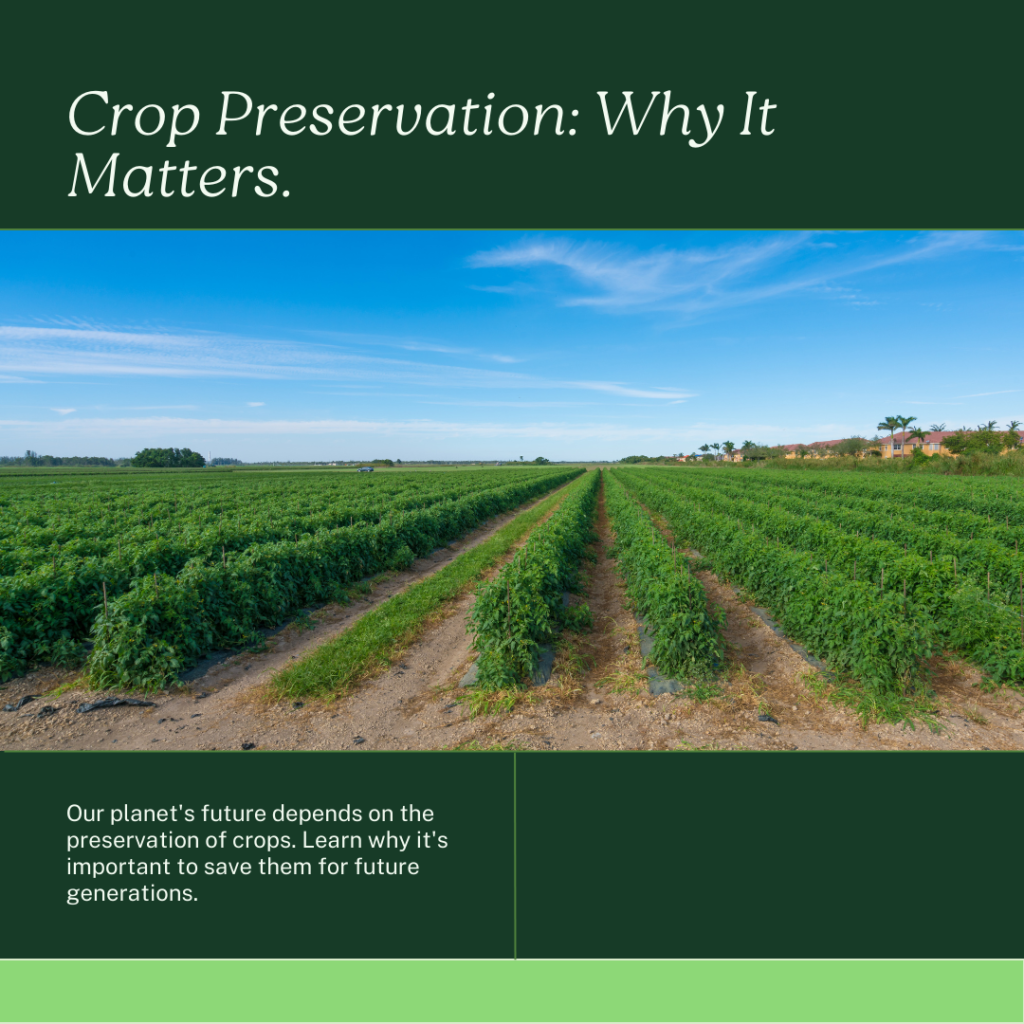
Crop preservation plays a vital role in preventing spoilage and ensuring the longevity of your produce. Proper storage and preservation techniques not only help extend the shelf life of your harvested crops but also maintain their quality and nutritional value. Whether you’re a farmer, gardener, or simply want to maximize the freshness of your home-grown autumn crops, understanding the importance of crop preservation is essential.
Why is Crop Preservation Important?
Proper preservation of harvested crops offers several benefits:
- Minimizes waste: Effective preservation techniques reduce the risk of spoilage and waste, allowing you to make the most of your hard-earned harvest.
- Extends shelf life: By employing suitable preservation methods, you can significantly prolong the storage life of your crops, ensuring you have access to fresh produce long after the harvest season.
- Preserves nutritional value: Correct preservation techniques help retain the nutritional content of your crops, ensuring you can enjoy their vitamins, minerals, and other beneficial nutrients for an extended period.
Preserving your autumn crops is not only practical but also cost-effective. By avoiding unnecessary spoilage and minimizing food waste, you can save money while enjoying the fruits of your labor for a more extended period.
Practical Tips for Effective Crop Preservation
To help you preserve your autumn crops effectively, here are some practical tips:
- Proper cleaning: Thoroughly clean your harvested crops to remove dirt, pests, and any debris that can accelerate spoilage.
- Optimal temperature and humidity: Store your crops in a cool, dry place. Different crops have specific temperature and humidity requirements, so it’s crucial to research and provide the ideal conditions for each variety.
- Airtight containers: Utilize airtight containers, such as glass jars or vacuum-sealed bags, to protect your crops from air exposure, moisture, and pests.
- Appropriate labeling: Label your preserved crops with the harvest date and crop name to easily track their freshness and avoid confusion.
- Freezing and canning: Consider freezing or canning your crops to further extend their shelf life. These methods are particularly effective for fruits, vegetables, and soups.
- Drying and dehydrating: Herbs, spices, and certain fruits can be dried or dehydrated for long-term storage.
By following these preservation techniques, you can enjoy the flavors and nutritional benefits of your autumn crops well beyond the harvest season.
[caption: Proper crop preservation techniques help extend the shelf life of your harvested autumn crops]Maximizing Shelf Life and Quality
When it comes to your harvested autumn crops, ensuring their longevity and maintaining their quality is crucial. Proper storage and preservation techniques play a significant role in achieving this. By following the right methods, you can extend the shelf life of your produce and enjoy its freshness for longer periods.
Proper Storage Methods for Harvested Crops
Proper storage is key to preserving the quality of your harvested crops. Here are some essential tips:
- Remove any damaged or spoiled crops before storing to prevent them from affecting the others.
- Store crops in a cool, dry, and well-ventilated area. This helps prevent moisture buildup and reduces the risk of mold and decay.
- Use containers or bins that allow for air circulation while protecting the crops from pests and rodents.
- Depending on the crop, consider using specific storage methods such as refrigeration, freezing, or canning.
Preservation Techniques to Extend Shelf Life
In addition to proper storage, various preservation techniques can help extend the shelf life of your harvested crops:
- Canning: This method involves sealing the crops in jars or cans with preservatives, allowing you to enjoy them even months after harvesting.
- Drying: Drying removes moisture from the crops, making them less susceptible to spoilage. You can sun-dry or use a dehydrator to preserve crops like herbs, fruits, and vegetables.
- Freezing: Freezing is an excellent technique for preserving the freshness and quality of many crops. Blanching the vegetables before freezing can help retain their color and texture.
- Fermentation: Fermenting crops like cucumbers and cabbage can extend their shelf life while adding unique flavors.
By utilizing these storage and preservation techniques, you can make the most of your harvested autumn crops. Not only will you have access to fresh produce for longer, but you’ll also reduce waste and maximize the value of your hard work.
Remember, each crop may require specific storage and preservation methods. Research the best practices for your specific crops to ensure optimal results.
Expert Tips for Harvesting Success
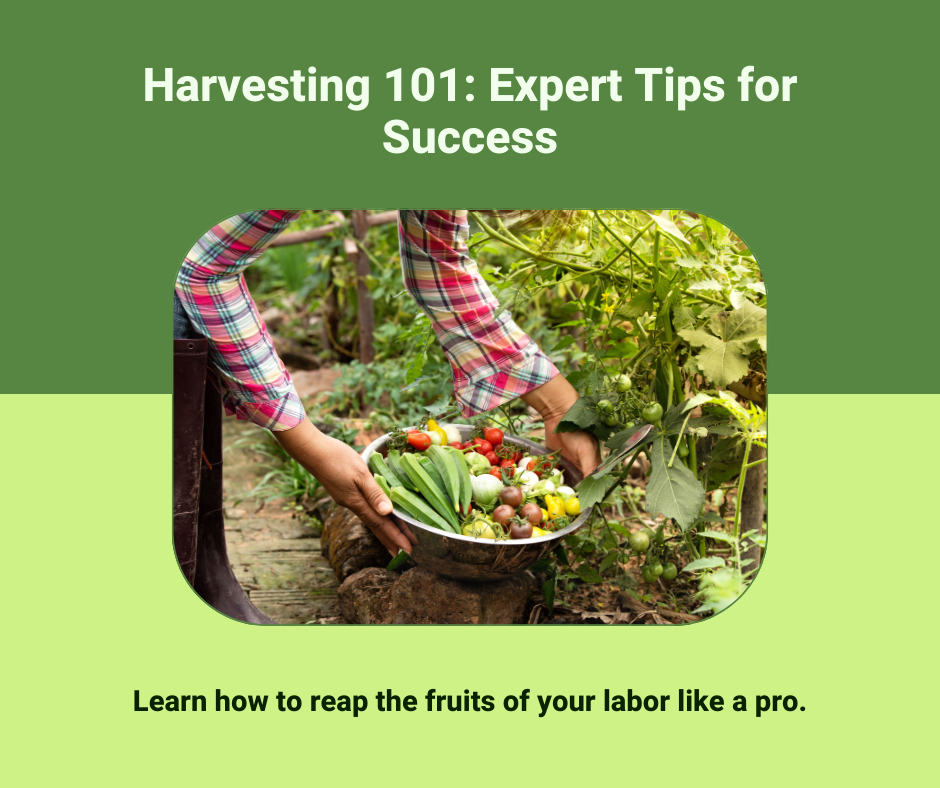
To maximize your autumn crop yield and ensure a successful harvest, it’s essential to follow expert tips and advice tailored for the season. These insider secrets and valuable insights will help you make the most of your efforts and enjoy a bountiful harvest. Here are some key tips to keep in mind:
1. Timing is Everything
Timing plays a crucial role in autumn crop harvesting. Each crop has its own ideal harvesting time, so it’s important to familiarize yourself with the specific harvest window for each crop you’re growing. By harvesting at the right time, you can maximize the flavor, texture, and nutritional value of your produce.
2. Handle with Care
When harvesting your autumn crops, be gentle to minimize damage and ensure the highest quality. Use sharp, clean tools to avoid bruising or tearing the produce. Remember to handle delicate fruits and vegetables, such as berries, with extra care to preserve their integrity.
3. Storage Techniques
Proper storage techniques are vital for maintaining the freshness and extending the shelf life of your harvested crops. Consider using storage methods such as canning, freezing, or drying to ensure your produce stays in excellent condition for longer periods.
4. Preserving the Flavor
To preserve the delicious flavors of your autumn crops, consider different preservation techniques. Whether it be pickling, making jams or jellies, or even fermenting, these methods can enhance the taste and extend the enjoyment of your harvest throughout the year.
5. Stay Organized
Keeping track of what you’ve harvested and the storage method used is essential for easy access and rotation. Label your stored crops with dates and contents to maintain an organized system. This will help you make the most efficient use of your harvest and avoid spoilage.
“Success in autumn crop harvesting lies in a combination of timing, care, storage, preservation, and organization. By following these expert tips, you’ll be on your way to a successful and fruitful harvest.”
| Crop | Optimal Harvesting Time |
|---|---|
| Apples | September – October |
| Pumpkins | September – November |
| Carrots | September – November |
| Brussels Sprouts | October – November |
By following these tips and paying attention to the specific needs of each crop, you can ensure a successful autumn crop harvest. Enjoy the bountiful rewards of your hard work and make the most of the harvest season.
FAQ
Q. When is the best time to harvest autumn crops?
A. The timing for harvesting autumn crops depends on the specific crop and its maturity. Generally, it’s best to harvest when the fruits or vegetables are fully ripened and ready to be picked. Keep in mind that weather conditions and the specific crop variety can also influence the ideal harvest time.
Q. How can I prepare for efficient autumn crop harvesting?
A. To prepare for efficient autumn crop harvesting, make sure you have all the necessary tools and equipment ready, including pruning shears, garden gloves, and baskets or containers for collecting the harvest. It’s also important to clear the area from weeds and debris, ensuring easy access to the crops.
Q. What are the essential tools for autumn crop harvesting?
A. The essential tools for autumn crop harvesting include pruning shears or secateurs for cutting stems and branches, garden gloves for protecting your hands, and containers or baskets for collecting the harvested crops. It’s also recommended to have a sharp knife or scissors for trimming and a garden fork or spade for lifting root vegetables.
Q. How should I maintain and ensure safety when using harvesting equipment?
A. Regular maintenance of your harvesting equipment is important to ensure its efficiency and longevity. Clean the tools after each use and apply lubrication to prevent rust. Sharpen blades regularly to ensure clean cuts. When using the equipment, follow safety guidelines and wear protective gear such as gloves and goggles to prevent injuries.
Q. What are the best crops for autumn harvesting?
A. The best crops for autumn harvesting include root vegetables such as carrots, beets, and potatoes, as well as cool-season greens like kale and spinach. Other popular choices include pumpkins, winter squash, and various types of apples. Choose crops that are suited to your climate and have a longer maturation period to ensure a successful autumn harvest.
Q. What are the best practices for harvesting different crops?
A. The best practices for harvesting different crops vary depending on the specific crop. However, a general rule of thumb is to use clean and sharp tools to minimize damage to the plants. Gently handle the harvested crops to avoid bruising or crushing. For root vegetables, carefully dig them out to prevent breakage. It’s also important to harvest in the morning when the crops are cool and fully hydrated.
Q. How can I store my harvested crops properly?
A. Proper storage is essential to prolong the shelf life of your harvested crops. Store root vegetables in a cool and dark place to prevent sprouting and moisture loss. Fruits like apples and pears should be kept in a cool and humid environment to maintain their crispness. Leafy greens can be stored in the refrigerator in airtight bags or containers. For longer preservation, consider canning, freezing, or drying the crops.
Q. What preservation techniques can I use to extend the shelf life of my crops?
A. To extend the shelf life of your crops, consider preserving them through various techniques. Canning is a popular method for preserving fruits and vegetables in jars, while freezing helps to maintain their freshness and nutritional value. Drying or dehydrating is another option that can be used for herbs, fruits, and certain vegetables. Additionally, pickling and fermenting are effective methods for preserving vegetables.
Q. How can I maximize the shelf life and quality of my harvested crops?
A. To maximize the shelf life and quality of your harvested crops, it’s important to handle them with care. Remove any damaged or bruised produce to prevent spoilage. Keep fruits and vegetables separate as ethylene gas produced by fruits can accelerate ripening and spoilage in vegetables. Store crops at the ideal temperature and humidity levels, regularly checking for signs of decay or mold.
Q. What are some expert tips for harvesting success?
A. For harvesting success, pay attention to the maturity indicators of each crop and harvest them when they are at their peak ripeness. Use proper harvesting techniques, such as cutting fruits and vegetables at the stem or stalk and gently lifting root vegetables from the ground. Promptly cool and clean harvested crops to maintain their quality. Lastly, store them properly to ensure their longevity.
Q. How can autumn crop harvesting be tailored for the season?
A. Tailoring autumn crop harvesting for the season involves considering the specific weather conditions during this time, such as cooler temperatures and shorter daylight hours. Adjust your harvest schedule accordingly and make sure to complete the harvest before frost or extreme cold sets in. Also, take advantage of seasonal produce preservation methods like canning and drying to fully enjoy the flavors of autumn throughout the year.
Conclusion
Harvesting your autumn crop successfully requires careful planning, proper timing, and the right techniques. By following the tips and recommendations outlined in this article, you can maximize your yield and ensure the quality and longevity of your harvested crops.
Remember to consider the specific needs of each crop and tailor your harvesting methods accordingly. Use the essential tools and equipment recommended for autumn crop harvesting to minimize damage and optimize efficiency. Additionally, explore crop selection and choose the varieties that are best suited for autumn harvesting in your region.
Once your crops are harvested, proper storage and preservation techniques become crucial. Employing the best practices for storing your autumn crops will help maintain their freshness and extend their shelf life. Implement preservation techniques such as canning, freezing, or drying to further enhance longevity.
In conclusion, with the right knowledge and strategies, you can have a successful autumn crop harvest. By maximizing your yield and preserving the quality of your crops, you can enjoy the fruits of your labor well beyond the harvest season.





